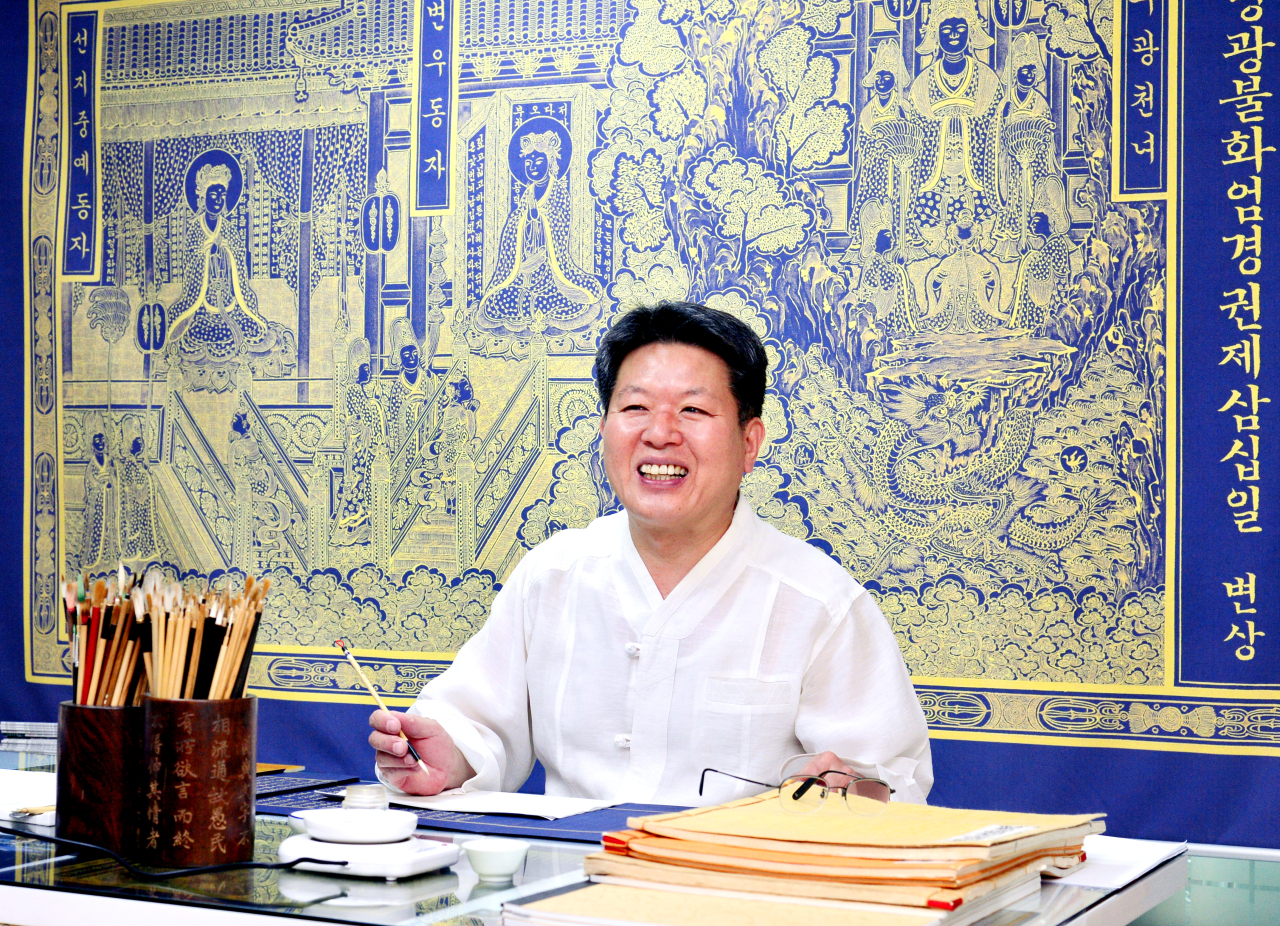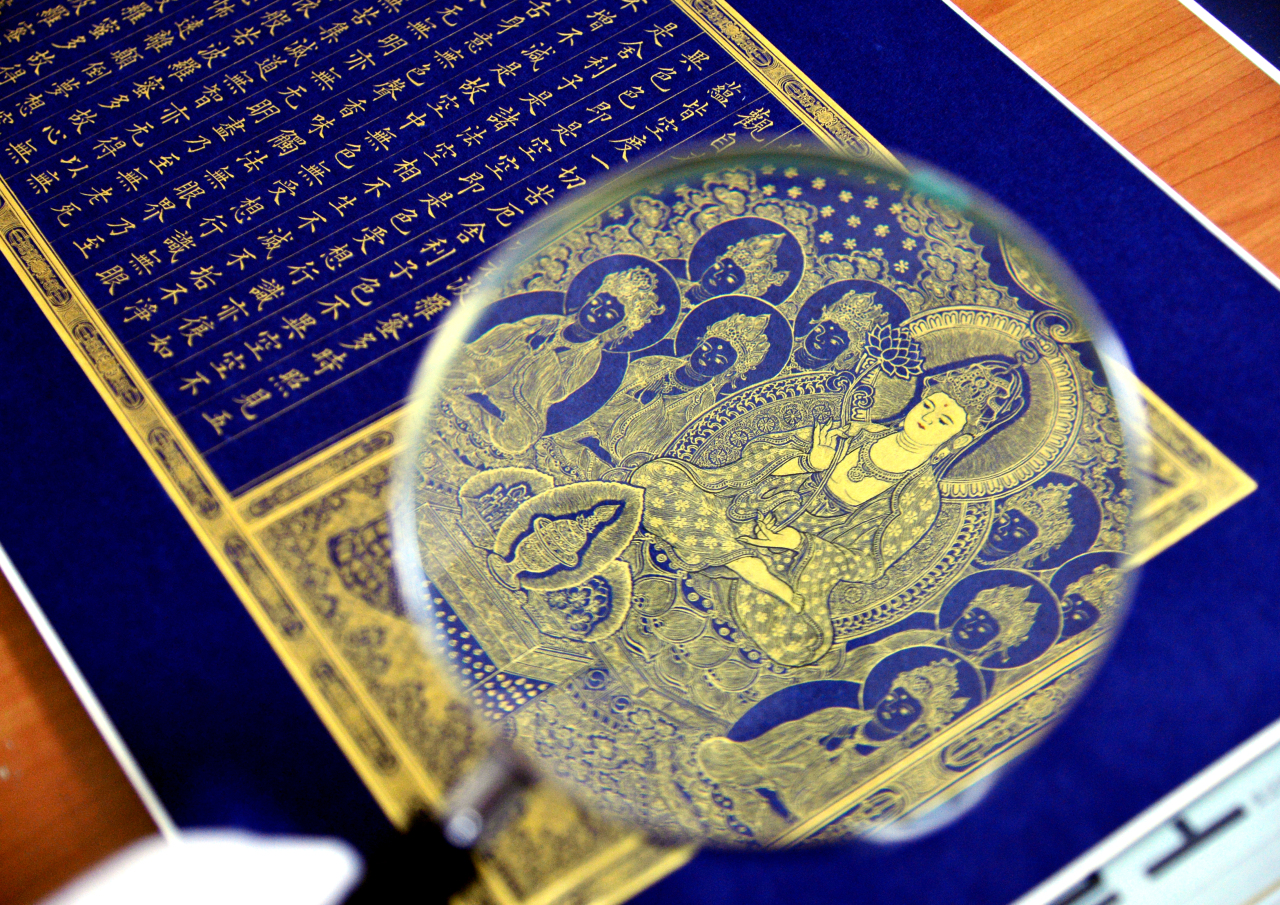To call Kim Kyeong-ho a master calligrapher seems like an understatement.
 |
Kim Kyeong-ho (Park Hyun-koo/The Korea Herald) |
His transcriptions of the sutras, the Buddha’s teachings, lead viewers to wonder about the limits of human ability.
Ultrathin lines no thicker than a fraction of 1 millimeter form intricate designs and paintings that decorate the scripts. One such example depicts Buddha figures, almost invisible if not scrutinized with a magnifying glass, hidden inside minuscule pagodas.
“I did this many years ago. I don’t know how I did it back then,” Kim, 57, said, showing his work at his studio in Yeonhui-dong, Seoul, Monday.
He still continues to practice “sagyeong,” the act of copying out Buddhist scriptures, but says he is past his prime for creating such intricate work.
“I still have no problem concentrating, but it’s my eyes. As I age, I can’t stop myself from blinking too often.”
Exposing an inner perfectionist, he went on to explain the level of self-discipline he imposed on himself and why a blink of the eyes is too big a distraction.
 |
Kim Kyeong-ho's beautifully illuminated Buddhist sutra transcription (Park Hyun-koo/The Korea Herald) |
“I always work at night. Through the night. Straight for six to 10 hours. I don’t allow anything to interrupt,” he said.
The temperature of the room has to be maintained at 35 degrees Celsius or above for handwriting and at least 43 degrees for more precise work, such as painting. This is necessary to prevent the paint -- a mixture of gold or silver powders and glue -- at the tip of the brush from hardening.
“The higher the humidity, the better it is. Basically, the finest working environment means the highest discomfort index for me,” he said.
Asked how he manages to draw such thin lines, he said: “(One millimeter) shouldn’t look like 1 millimeter. When I reach a certain state of concentration, the space opens up and becomes much wider.”
Kim is the only master recognized by the government in the field of sagyeong. His skills and knowledge are unmatched.
It was his arduous endeavors that revived the art, which dates back to the fourth century but had been lost for over six centuries.
“In 1997, the country’s very first sagyeong competition (in modern times) was held, in which I happened to take the No. 1 position. That was the beginning,” Kim said.
At that time, devout believers, including him, would copy out sutras as a form of spiritual discipline. But little was studied about sagyeong as the centuries-old Buddhist art and tradition, and there was no real attempt to revive it.
Then, as a calligraphy teacher who liked to transcribe sutras, he had a chance to participate in the contest and was eager to do so. But he didn’t know it would change the course of his life.
“No one told me anything, but I took the prize with enormous responsibility and decided to devote myself to it,” he said. The annual competition continued only for a few more years, he added.
On a self-imposed mission to revive the art of sagyeong, in the absence of Korean materials he pored through Japanese historical documents for hints about the skills, tools and materials used by his ancestors. The Korean art originated from China and also spread to Japan, he explained.
“There are sagyeong artifacts over 1,000 years old that still remain intact. I had to see them with my own eyes. I was desperate, but it was hard to persuade owners to show their treasures to me -- I was a nobody at that time,” he recalled.
Understanding how it was done led him to a new challenge -- acquiring the necessary skills to reach that level of artistry and taking it a step further, developing it into an art form that is relevant today.
“I didn’t want to stop at a mere reproduction of traditional art. I wanted to make it my own and get better than any artists in the Goryeo era,” said Kim, who uses the pen name “Oegil,” which means the only path.
The Goryeo Kingdom (918-1392) is when sagyeong reached its pinnacle, he explained. With the use of gold and silver paints instead of ink, the exquisite hand-copied scriptures formed the centerpiece of the art world at that time along with Buddhist paintings and celadon.
Kim’s works were exhibited in New York and Shanghai earlier this year and discussions are underway for shows next year at several American universities, he said.
By Lee Sun-young (
milaya@heraldcorp.com)









